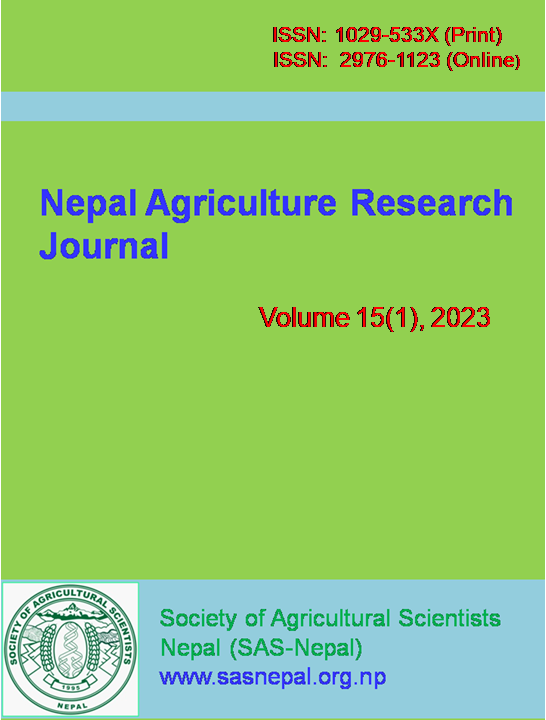Evaluation of cauliflower genotypes to different planting dates for early production in Kathmandu valley
DOI:
https://doi.org/10.3126/narj.v15i1.51320Keywords:
Early cauliflower, growth, planting dates, yieldAbstract
A field experiment was conducted to evaluate ten cauliflower genotypes at the National Horticulture Research Centre, Khumaltar, Lalitpur from June to December of 2019 and 2020. The experiment was laid out in Randomized Completely Block Design with ten genotypes (Chinese, Sarlahi Deepali, Pusa Katiki, Taichun, Pusa Sarad, Terai 1, Terai 2, Agheni, Cold Queen and Khumal Jyapu) planted on three dates i.e. June 25, July 15, and August 5 at a 20-day interval. The main objective of this study was to identify planting dates for cauliflower genotypes suitable recommended to planting in early-season under Kathmandu valley conditions. The results showed that planting dates significantly influenced the growth and yield of cauliflower genotypes. At 25th June planting, the genotype Sarlahi Deepali had the significantly lowest days to curd maturation (41 days after transplanting), which was at par with Pusa Katki and Terai -2 (46 DAT) with the lowest yield of 4.0 mt ha-1 and 3.2 mt ha-1, respectively. However, curd weight (438.6 g) and yield (27.4 mt ha-1) were recorded as the maximum in Chinese with 51 days maturity period. On the 15th July planting, Terai 2 had the lowest maturity days (44 DAT), but lower yield (14.6 mt ha-1), while Cold Queen had the highest curd weight and yield (560.8 g and 35.1 mt ha-1), which was at par with Chinese (546.7 g and 34.2 mt ha-1). Similarly, on the 5th August planting, the genotype Terai 2 had the significantly (p<0.001) lowest days to maturity (46 DAT), followed by Sarlahi Deepali (57) and Pusa Katiki (57), whereas the genotype Cold Queen had the highest curd weight and yield (842.1 g and 52.6 mt ha-1), followed by Taichun (718.8 g and 44.9 mt ha-1) and Terai 1 (452 g and 28.3 mt ha-1). The results revealed that genotype Sarlahi Deepali was found to be early maturing for June planting, while Terai 2 was found early for July and August planting, but were not found suitable due to lower yield. The genotypes Chinese and Cold Queen were found best for June and July planting, respectively. Similarly, Cold Queen and Taichun were promising genotypes for August planting.
Downloads
Downloads
Published
How to Cite
Issue
Section
License
Copyright (c) 2023 Pradhan

This work is licensed under a Creative Commons Attribution-NonCommercial 4.0 International License.
This license allows reusers to copy and distribute the material in any medium or format in unadapted form only, for noncommercial purposes only, and only so long as attribution is given to the creator.




